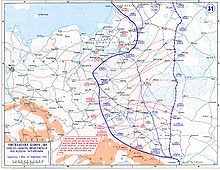11th Army (German Empire)
As 11th Armies / Army High Command 11 (AOK 11) , some large formations and the associated command authorities of the German army were designated during the First World War (1914-1918). They each comprised several army or reserve corps as well as numerous special troops.
history
First lineup
|
On February 22, 1915, Colonel Ernst von Wrisberg, as head of the army department in the Prussian War Ministry, suggested creating an operational reserve , in which the divisions of the Western Front should each surrender their fourth regiment. The proposal was received very positively, and by the end of March 1915 14 new divisions with war-experienced personnel were created in this way. The Chief of the General Staff, General of the Infantry Erich von Falkenhayn originally wanted to use these new forces in the west, but at the beginning of April the decision was made to deploy these reserves on the Eastern Front .
In order to manage this, the order was given as early as March 3, 1915 to set up a new Army High Command with the number 11 (AOK 11) for the special use of the Supreme Army Command . On March 9, General of the Infantry Max von Fabeck was appointed his Commander-in-Chief and Colonel Hans von Seeckt was appointed Chief of Staff. On March 11th, the members of the new AOK 11 met in Kassel and then moved to Maubeuge on March 15th . In the next few weeks, AOK 11 had the task of exploring the area north of Arras for an offensive. On March 28, 1915, General von Fabeck was transferred to the 1st Army as the new Commander-in-Chief to replace Colonel General Alexander von Kluck , who was wounded there . The management of AOK 11 was therefore initially the responsibility of Colonel von Seeckt. It was not until April 16 that the Army High Command was informed of its intended transfer to the Eastern Front and its use in an offensive there. At the same time, Colonel General August von Mackensen was appointed the new Commander-in-Chief of the 11th Army. The move began the following day, and on April 19 the Army High Command was in Teschen and then in Neu-Sandetz .
The first transports of eight German divisions arrived on April 21, and the new commander-in-chief arrived on April 25. At the end of April, the 11th Army had the following troops:
|
In total there were eight German and two Austro-Hungarian divisions. On May 2, 1915, the attack of the 11th Army and the operationally subordinate 4th Austro-Hungarian Army began the four-day battle of Gorlice-Tarnów , which ended with an operational breakthrough through the Russian lines. In the weeks that followed, the army pursued the retreating Russian troops, taking more than 250,000 prisoners by the end of June 1915. In the weeks that followed, further offensive operations (→ Great Withdrawal ) succeeded in pushing the Russian units far back. After these successes, however, a regrouping had to take place in order to be able to mobilize more troops against Serbia . For this reason, the high command of the 11th Army was dissolved on September 18, 1915 and its staff used to set up the general staff of Army Group Mackensen .
Second lineup
|
On the territory of the Austro-Hungarian monarchy, in the Banat , German troops were made available for an offensive against Serbia in autumn 1915 . These included the following associations:
As early as September 30, 1915, the management bodies were reorganized. The Army High Command 12 under Artillery General Max von Gallwitz was released from the Eastern Front to lead earmarked for the offensive against Serb forces. At the same time it was renamed Army High Command 11 .
Together with the 3rd Austro-Hungarian Army and the Bulgarian 1st Army, it was subordinate to the Mackensen Army Group in the forthcoming offensive against Serbia . The offensive began on October 6, 1915 and led to the defeat of the Serbian army and the occupation of the country by the end of November 1915. After a regrouping phase, the 11th Army secured the border with Greece on the Saloniki Front from February / March 1916 , where an Entente army had landed. The Army High Command remained in action here.
The headquarters of the Army High Command was from January 31, 1916 in Veles and then from October 5, 1916 in Prilep . The withdrawal since September 21, 1918 was gradual via Jagodina to Szolnok (Hungary). From there it was relocated to Allenstein in East Prussia on December 7, 1918 .
literature
- Holger Afflerbach: Falkenhayn. Political thinking and acting in the German Empire. Oldenbourg-Verlag, Munich 1994, ISBN 3-486-559-72-9 , ( Contributions to military history. 42), (At the same time: Düsseldorf, Univ., Diss.).
- Hermann Cron: History of the German Army in the World War 1914–1918. Siegismund, Berlin 1937 ( History of the Royal Prussian Army and the German Imperial Army 5).
- Hans Meier-Welcker : Seeckt. Bernard & Graefe et al., Frankfurt am Main 1967.
- Friedrich von Rabenau (ed.): Seeckt. Out of my life. Volume 1: 1866-1917 . Publishing house Hase & Koehler, Leipzig 1941.
Web links
- The highest command posts of the army on www.deutsche-kriegsgeschichte.de (as of April 16, 2010)
Individual evidence
- ↑ a b c d Hermann Cron: History of the German Army in the World War 1914–1918 , Berlin 1937, p. 398
- ^ Holger Afflerbach: Falkenhayn - Political Thought and Action in the Empire. Munich 1994, p. 286f.
- ↑ Friedrich von Rabenau (ed.): Seeckt - From my life. Volume 1. Leipzig 1941, p. 99.
- ↑ Friedrich von Rabenau (ed.): Seeckt - From my life. Volume 1. Leipzig 1941, p. 102f.
- ↑ Friedrich von Rabenau (ed.): Seeckt - From my life. Volume 1. Leipzig 1941, pp. 110, 113.
- ^ Hans Meier-Welcker: Seeckt. Frankfurt / Main 1967, p. 52.
- ↑ ( 11th Bavarian Infantry Division and 119th Infantry Division ) under the command of the Commander of the Bavarian Division Major General Paul Ritter von Kneussl
- ^ Helmut Otto / Karl Schmiedl: The First World War. Berlin (East) 1977, p. 135.
- ^ Hermann Stegemann: History of the war. Volume 3. Stuttgart / Berlin 1919, p. 453.
- ↑ a b Hermann Cron: History of the German Army in World Wars 1914–1918 , Berlin 1937, p. 79


